
Building a workplace where employees feel heard requires more than annual check-ins. At Matter, we recognize that organizations encounter significant challenges in maintaining meaningful connections with their teams while gathering timely insights that drive genuine change. Traditional engagement surveys often leave companies waiting months for feedback, missing critical moments when intervention could prevent turnover or boost morale. This reactive approach can lead to disengagement, missed opportunities for improvement, and ultimately, a disconnect between leadership and employees.
Pulse surveys offer a powerful solution by creating continuous feedback loops that keep organizations aligned with employee sentiment throughout the year. These brief, frequent check-ins provide actionable insights that help HR leaders identify issues before they escalate, track trends in real time, and demonstrate to employees that their voices genuinely matter. By implementing pulse surveys strategically, companies can transform how they listen to and respond to their workforce, creating a culture where feedback drives meaningful action and employees feel valued every day.
What is a pulse survey and why it matters for employee engagement

A pulse survey is a short, frequent questionnaire designed to measure employee sentiment and gather timely feedback on specific aspects of the workplace experience. Unlike comprehensive annual engagement surveys, which may include 50-80 questions, pulse surveys typically contain 5-15 targeted questions that employees can complete in just a few minutes. Organizations conduct these surveys on a regular cadence, whether weekly, biweekly, or monthly, to maintain a consistent pulse on organizational health and employee engagement.
The value of pulse surveys extends beyond simple data collection. They create an ongoing dialogue between management teams and employees, signaling that leadership actively seeks input and values employee perspectives. This continuous feedback mechanism enables companies to identify trends, address concerns promptly, and make data-driven decisions that enhance the employee experience. When implemented effectively, pulse surveys transform feedback from an annual checkbox exercise into a dynamic tool for continuous improvement.
How pulse surveys differ from traditional employee engagement surveys
Traditional annual employee engagement surveys provide comprehensive snapshots of organizational health, but often suffer from timing limitations. By the time results are analyzed and action plans developed, the issues identified may have evolved or intensified. Annual engagement surveys typically measure broad themes across the entire employee lifecycle, requiring a significant time investment from both participants and analysis teams.
Pulse surveys operate differently by focusing on specific topics through shorter, more frequent check-ins. This approach offers several advantages:
- Immediate relevance: Questions address current workplace conditions rather than asking employees to recall experiences from months ago
- Faster action cycles: Organizations can identify issues and implement solutions within weeks rather than waiting for annual results
- Reduced survey fatigue: Brief surveys respect employees' time while maintaining engagement through varied question sets
- Trend tracking: Companies can rapidly assess the effects of changes by conducting routine data collection, which identifies patterns.
The frequency and brevity of pulse surveys create a more agile feedback system. While annual surveys remain valuable for comprehensive organizational assessments, pulse surveys provide the real-time feedback necessary to respond to emerging challenges and opportunities. Many organizations find success by combining both approaches, using annual engagement surveys for in-depth analysis and pulse surveys to monitor progress on specific initiatives.
The science behind frequent feedback and employee satisfaction
Research consistently demonstrates that employees who receive regular feedback report higher job satisfaction and stronger connections to their work. Frequent check-ins create psychological safety by normalizing conversations about workplace challenges and successes. When employees know they'll have regular opportunities to share their perspectives, they feel more invested in the organization's direction and more confident that their input matters.
The impact of frequent feedback extends to organizational metrics as well. Companies that implement pulse surveys often see improvements in various aspects of workforce management:
- Enhanced employee motivation through visible action on feedback
- Stronger manager support as leaders receive timely data about their teams
- Better identification of retention risks before employees decide to leave
- Increased participation rates compared to lengthy annual surveys
Pulse surveys help organizations move from reactive to proactive people management. By continuously tracking employee sentiment, HR leaders can identify declining engagement scores, emerging concerns about company culture, or gaps in professional development opportunities before these issues impact business outcomes. This early warning system allows companies to intervene strategically, allocating resources where they'll have the most positive impact on employee experience and organizational success.
Key metrics that pulse surveys measure for organizational success
Effective pulse surveys focus on metrics that directly connect to organizational health and business performance. Rather than measuring everything at once, successful pulse survey strategies concentrate on specific dimensions that provide actionable insights. These measurements help organizations understand not just how employees feel, but why they feel that way and what actions might improve their experience.
Core metrics that pulse surveys commonly track include employee engagement levels, which reflect how connected employees feel to their work and the organization's mission. Pulse surveys also analyze manager support, determining if employees receive the necessary advice and resources to thrive. Career development satisfaction indicates whether employees perceive growth opportunities within the organization, while questions about company culture assess their alignment with the organization's stated values.
Additional valuable metrics include:
- Recognition and appreciation: Whether employees feel acknowledged for their contributions
- Work-life balance: How well employees manage professional and personal responsibilities
- Communication effectiveness: Whether employees receive clear, timely information from leadership
- Psychological safety: The degree to which employees are at ease providing candid feedback
- Organizational confidence: Employee trust in leadership decisions and company direction
By rotating focus areas across pulse surveys, organizations can maintain a comprehensive view of employee sentiment without overwhelming participants. This targeted approach ensures each pulse check delivers specific, actionable feedback that leaders can address through concrete action plans.
35+ essential pulse survey questions for maximum employee insights

Creating effective pulse survey questions requires striking a balance between comprehensiveness and brevity, while ensuring each question yields actionable data. Well-designed survey questions provide clarity about what organizations need to improve and help employees feel their feedback will drive meaningful change. The most valuable pulse surveys include a mix of quantitative ratings and open-ended opportunities for employees to elaborate on their experiences.
Organizations should design pulse survey questions that align with their current priorities and challenges. During periods of organizational change, questions might focus on communication and clarity. When addressing retention concerns, questions about job satisfaction and career development become priorities. This flexibility enables companies to utilize employee pulse surveys as dynamic tools that adapt to evolving business needs while maintaining regular feedback loops with employees.
35 pulse survey question examples across key engagement areas:
Core engagement questions
- How much do you value your profession on a scale of strongly disagreeing to strongly agreeing?
- Do you feel your manager and team value your contributions?
- Would you recommend this organization as a great place to work?
- Do you have the resources and support needed to perform your job effectively?
- How confident are you in the organization's leadership and future direction?
- Do you understand how your work contributes to the organization's goals?
- How motivated do you feel to go above and beyond in your role?
- Do you feel proud to work for this organization?
These core questions create a foundation for understanding employee sentiment across the organization. When employees consistently provide honest answers to these fundamental questions, HR leaders gain valuable insights into which teams are thriving and which may require additional support. Tracking responses over time also helps organizations measure whether new initiatives or changes have a positive impact on how employees experience work.
Organizations should use consistent rating scales across these questions to enable meaningful comparisons. Many pulse surveys use five-point Likert scales, ranging from "strongly disagree" to "strongly agree," or other variations that allow employees to express nuanced opinions. The key is maintaining consistency so that pulse survey data remains comparable across survey periods and organizational units.
Workplace culture and values questions
- Do you believe your team consistently demonstrates the organization's core values?
- How comfortable do you feel sharing your ideas and concerns with your manager?
- Does the organization promote diversity, equity, and inclusion in meaningful ways?
- Do you feel recognized and appreciated when you do great work?
- How well does leadership communicate about company direction and decisions?
- Does your team collaborate effectively to achieve shared goals?
- Do you feel psychologically safe expressing different opinions at work?
- Does the company's culture align with what was promised during the recruitment process?
Cultural alignment has a substantial effect on staff retention and performance. When employees feel the organization lives its values authentically, they report higher satisfaction and demonstrate stronger commitment. Pulse surveys help organizations monitor whether cultural initiatives translate into genuine employee experiences or remain leadership talking points that don't reflect workplace reality.
Including questions about employee recognition within culture assessments reveals whether appreciation happens regularly and authentically. Organizations that struggle with recognition often see lower engagement scores and higher turnover, making this a critical area for pulse survey measurement. The data from these questions helps companies understand whether recognition programs reach all employees or inadvertently favor certain teams or roles.
Career development and growth questions
- Do you see opportunities for career advancement within this organization?
- How satisfied are you with the professional development opportunities available to you?
- Does your current role align with your career goals and interests?
- Do you receive regular feedback that helps you improve your performance?
- Does your manager support your professional growth and development?
- Are you learning new skills that will advance your career?
- Do you have a clear understanding of what it takes to progress in your career here?
Career development questions help organizations identify whether employees see long-term futures within the company. When pulse surveys reveal gaps in development opportunities, HR teams can implement targeted training programs, mentorship initiatives, or clearer career pathways to address these needs. This proactive approach addresses retention risks before talented employees begin searching for growth opportunities elsewhere.
Manager effectiveness and support questions
- Does your manager provide clear expectations and direction?
- How often does your manager recognize your contributions and achievements?
- Does your manager help remove obstacles that prevent you from doing your best work?
- Do you trust your manager to support you during challenges?
- Does your manager communicate openly and transparently with the team?
- How effective is your manager at fostering team collaboration and engagement?
Manager support represents one of the strongest predictors of employee engagement and retention. Pulse surveys focused on manager effectiveness help organizations identify leadership development needs and recognize exceptional managers whose practices could be replicated across teams. When specific managers consistently receive low scores, HR can provide targeted coaching or intervention to prevent entire teams from disengaging.
Work-life balance and wellbeing questions
- How well does the organization support your work-life balance needs?
- Do you feel your workload is manageable and sustainable?
- Does the organization care about your wellbeing beyond work productivity?
- Do you have the flexibility to manage personal responsibilities when needed?
- How often do you feel stressed or overwhelmed by work demands?
- Does the organization provide adequate resources to support your mental and physical health?
These questions require careful handling, as they touch on sensitive topics that might concern employees if they believe their responses could be traced back to them. Ensuring pulse survey anonymity becomes particularly important when inquiring about retention intentions, career satisfaction, or concerns about well-being. Organizations must clearly communicate how they protect employee privacy while still utilizing aggregate pulse survey results to drive improvement.
By rotating these questions through pulse surveys, companies maintain employee engagement with the survey process while gathering comprehensive insights about various aspects of organizational health. This approach prevents survey fatigue while ensuring most employees have opportunities to provide feedback on topics most relevant to their experience.
When organizations discover retention risks or wellbeing concerns through pulse surveys, they can implement targeted employee rewards or support programs to address issues before employees disengage completely. This proactive approach demonstrates that leadership takes employee feedback seriously and invests in creating conditions where talented people want to stay and grow.
10+ top employee pulse survey tools and platforms comparison

Selecting the right pulse survey software has a significant impact on program success, as it determines how easily organizations can create surveys, how employees experience the feedback process, and what valuable insights emerge from survey data. Modern pulse survey tools offer a range of features, including question libraries, analytics dashboards, integration capabilities, and automation options. The best platform for any organization depends on factors like company size, existing technology systems, budget constraints, and specific measurement goals.
Organizations evaluating pulse survey platforms should prioritize solutions that simplify administration while providing robust analytics and insights. The ideal tool makes creating and distributing surveys effortless for HR teams while respecting employees' time through intuitive interfaces and mobile accessibility. Strong platforms also transform raw survey data into actionable insights through visualizations, trend analysis, and benchmarking capabilities, helping leaders understand what the numbers mean and where to focus their improvement efforts.
Enterprise-level pulse survey tools for large organizations
Large organizations require pulse survey software that can handle complex hierarchies, multiple locations, and thousands of employees while maintaining data security and providing granular analytics. Enterprise platforms typically offer advanced features, such as custom workflows, sophisticated reporting that preserves anonymity even in small team sizes, and integrations with existing HR technology stacks. These solutions prioritize scalability and customization to meet the unique needs of major corporations.
Leading enterprise pulse survey platforms include:
1. Matter

About Matter: Matter is a Slack-first and Teams-first recognition platform that seamlessly integrates with enterprise pulse survey programs by enabling organizations to immediately act on feedback through targeted recognition initiatives. When enterprise pulse surveys reveal that employees feel under-appreciated or disconnected from company values, Matter's customizable kudos cards enable leadership teams to address these concerns in real-time across thousands of employees. The platform's analytics dashboard enables enterprise teams to correlate recognition patterns with engagement data, providing comprehensive insights into how appreciation affects employee sentiment across large, distributed organizations.
Matter's enterprise capabilities shine through its ability to scale recognition efforts based on pulse survey insights. The platform's automated Feedback Friday feature ensures consistent recognition, addressing survey gaps without requiring manual intervention from busy HR teams managing global workforces. With robust integration into Slack and Microsoft Teams, Matter enables enterprise organizations to establish immediate feedback loops, where pulse survey results directly inform recognition strategies. This helps leadership demonstrate responsiveness to employee concerns across multiple departments, locations, and time zones.
Matter main features:
- Seamless Slack and Microsoft Teams integration for enterprise-wide deployment
- Customizable kudos cards that align with pulse survey feedback themes
- Automated Feedback Friday reminders, ensuring consistent recognition, and addressing survey gaps
- Analytics connecting recognition patterns with engagement metrics
Matter pricing:
- Free Forever: $0/user/month
- Basic: $1/user/month, billed annually
- Pro: $3/user/month, billed annually
- Pro + Surveys: $5/user/month, billed annually
To learn more, view Matter's pricing page.
Matter G2 score: Matter has a G2 score of 4.7/5 based on user reviews.
What Matter customers are saying: “Matter helps our employees feel more valued, rewarded, and recognized. It’s a very fun and easy-to-use platform that has created a positive experience and engagement for our people while also helping to reinforce our core values daily.” - Taylor Rapp, Director of People & Culture at True Classic (Customer Story).
2. Culture Amp
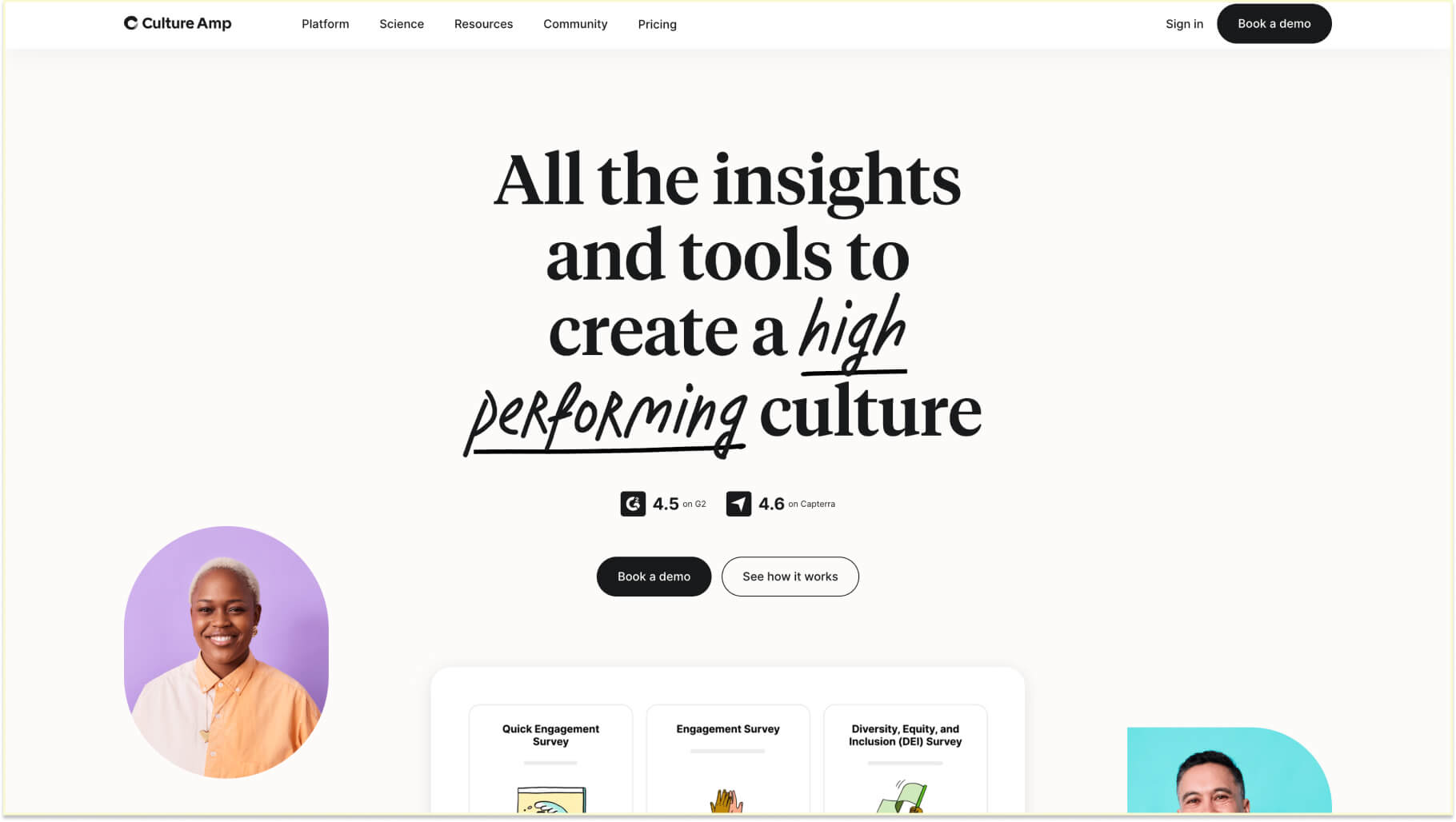
About Culture Amp: Culture Amp is an employee experience platform that helps organizations measure and improve company culture through engagement surveys, performance management, and development tools. The platform combines employee feedback with people analytics to help companies understand what drives engagement and retention across their workforce.
Culture Amp main features:
- Employee engagement surveys with research-backed templates
- Performance management and development tools
- People analytics and benchmarking data
- Action planning features to address survey results
Culture Amp pricing:
- Engage: contact the sales team for exclusive features
- Perform: contact the sales team for exclusive features
- Develop: contact the sales team for exclusive features
- People Analysis: contact the sales team for exclusive features
To learn more, view Culture Amp’s pricing page.
Culture Amp G2 score: Culture Amp has a G2 score of 4.5/5 based on user reviews.
What Culture Amp customers are saying on G2: “I’ve been using this software for a while now, and one of its standout features is how well-organized the system is. Everything is laid out in a clear and intuitive way, making it easy to navigate. Additionally, the punctuality of the communications is exceptional – notifications and updates are always timely, ensuring that I stay on top of tasks and deadlines. It’s a reliable tool for those who value efficiency and clear communication. Highly recommended!” - Anna L., SEO Consultant (G2 Review for Culture Amp).
3. Qualtrics EmployeeXM

About Qualtrics EmployeeXM: Qualtrics EmployeeXM (now part of SAP) offers the EmployeeXM platform as part of its Experience Management Suite. The platform offers enterprise-grade survey capabilities, including advanced analytics, predictive insights, and seamless integration with HR systems, to help organizations better understand and enhance their employee experience.
Qualtrics EmployeeXM main features:
- Advanced survey platform with sophisticated logic and branching
- Predictive analytics and AI-powered insights
- Integration with major HRIS platforms
- Real-time dashboards and reporting
Qualtrics EmployeeXM pricing: Pricing is not listed on the website. To learn more about pricing, you'll need to schedule a demo/sales call with Qualtrics EmployeeXM.
Qualtrics EmployeeXM G2 score: Qualtrics EmployeeXP has a G2 score of 4.4/5 based on user reviews.
What Qualtrics Employee XM customers are saying on G2: “Preston Donohoo, with Red Pepper, has been fantastic to partner with. He is thorough, excellent at training and his customer support is outstanding. He made our implementation go very smoothly. We have found the Qualtrics engagement survey and 360s tools easy to use, with the ability to dive deep into our results. We would definitely recommend Qualtrics to others.” - Kelli G., Global Talent Manager (G2 Review for Qualtrics EmployeeXM).
4. Glint
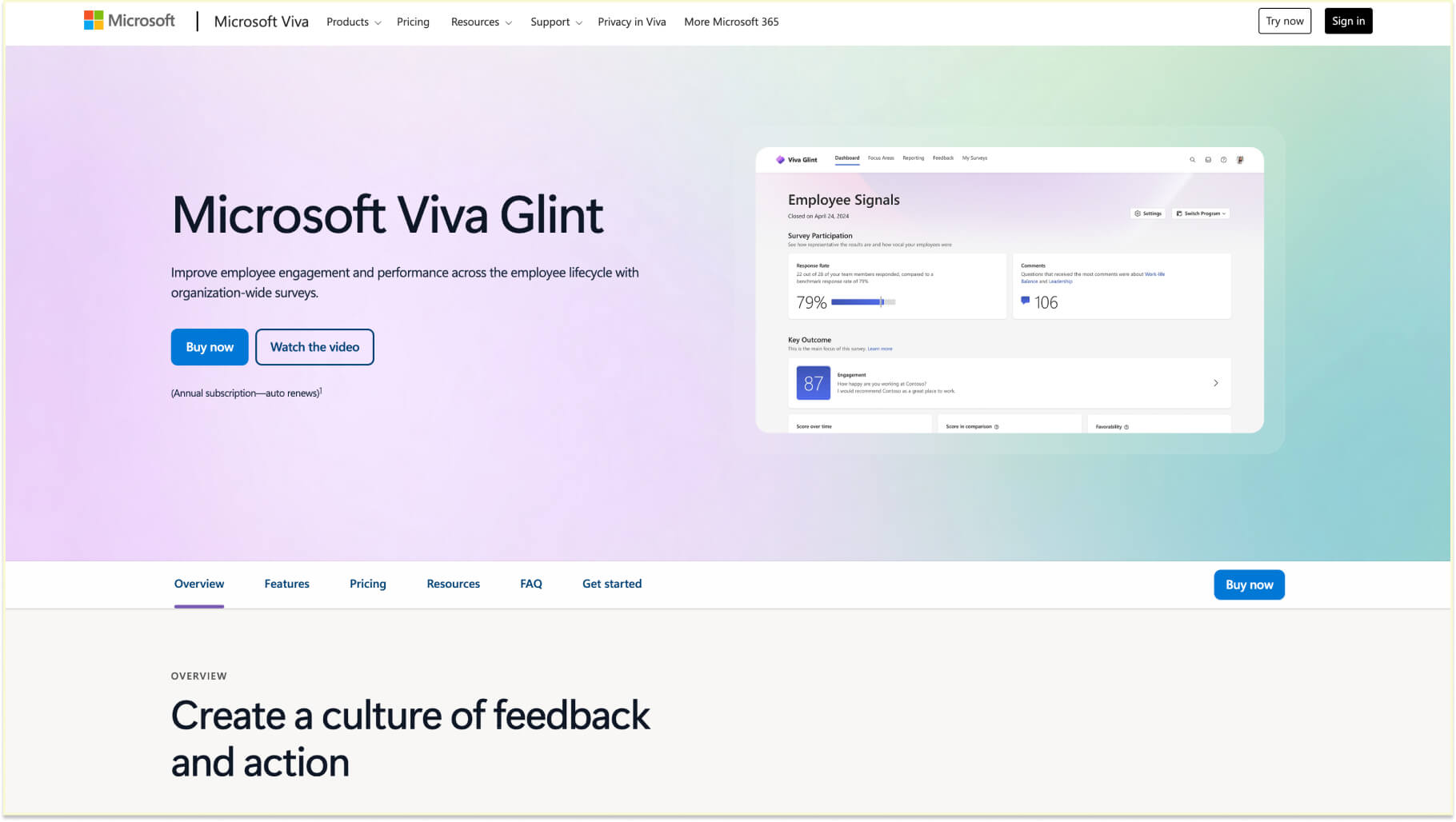
About Glint: Glint (now part of Microsoft Viva) is an employee engagement platform that utilizes AI and people analytics to help organizations understand employee sentiment and drive actionable insights. The platform offers pulse surveys, always-on feedback channels, and manager dashboards to create continuous listening programs.
Glint main features:
- AI-powered insights and recommendations
- Real-time manager dashboards
- Pulse surveys and always-on feedback
- Integration with Microsoft ecosystem
Glint pricing:
- Microsoft Viva Employee: $2.00 user/month (Annual commitment)
- Microsoft Viva Workplace: $6.00 user/month (Annual commitment)
- Microsoft Viva Suite: $12.00 user/month (Annual commitment)
To learn more, view Glint’s pricing page.
Glint G2 score: Glint has a G2 score of 4.6/5 based on user reviews.
What Glint customers are saying on G2: “Good depiction of data, easy to view formats with a variety of different cuts of data available. Not super user-friendly, requires too many clicks to filter the data needed.” - Anjali A., Human Resources Consultant (G2 Review for Software).
Organizations using enterprise platforms benefit from established question libraries based on research about what predicts various organizational outcomes. Rather than starting from scratch, HR leaders can select proven pulse survey questions that measure specific dimensions, such as manager effectiveness, organizational trust, or commitment to diversity.
Many platforms also enable pulse surveys to be delivered in multiple languages, which is essential for global organizations committed to hearing from all employees, regardless of their location.
Best pulse survey employee engagement solutions for small businesses
Small businesses need pulse survey tools that deliver enterprise-quality insights without requiring extensive setup or ongoing administration. The ideal solutions for smaller organizations offer intuitive interfaces that allow teams to launch their first pulse survey within hours, pre-built question sets based on best practices, and affordable pricing that makes regular feedback financially sustainable. These platforms focus on simplicity and speed while still providing the analytics needed to improve employee experience.
Top-rated pulse survey solutions for smaller organizations:
1. Matter
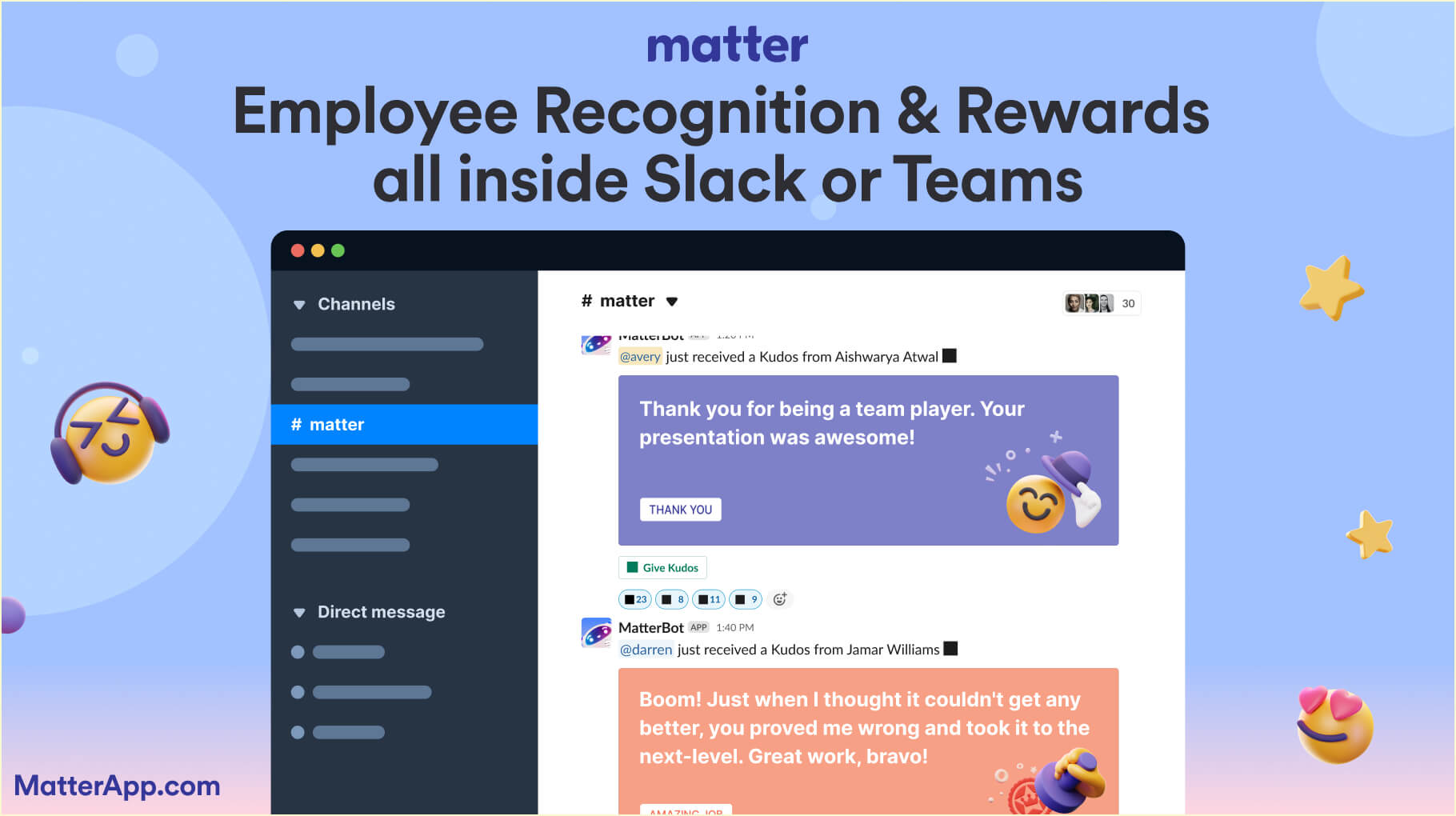
About Matter: Matter is perfectly suited for small businesses conducting pulse surveys because it provides immediate action mechanisms through its Free Forever plan and simple setup process that takes just minutes. When small business pulse surveys reveal that employees want more appreciation or feel disconnected from company values, Matter's customizable kudos cards and automated Feedback Friday reminders ensure recognition becomes consistent and meaningful without requiring dedicated HR staff or complex administration, making it ideal for resource-constrained small teams that need to demonstrate quick responsiveness to employee feedback.
Matter main features:
- Free Forever plan is ideal for small teams starting their engagement journey
- Set up in minutes without technical expertise required
- Automated weekly Feedback Friday reminders for consistent recognition
- Customizable kudos cards celebrating pulse survey-identified wins
Matter pricing:
- Free Forever: $0/user/month
- Basic: $1/user/month, billed annually
- Pro: $3/user/month, billed annually
- Pro + Surveys: $5/user/month, billed annually
To learn more, view Matter's pricing page.
Matter G2 score: Matter has a G2 score of 4.7/5 based on user reviews.
What Matter customers are saying: "Matter helps us encourage behaviors that align with our company values and can allow us to recognize and reward those who exemplify our values." - Autumn Amescua, Chief Culture & People Officer at SXSW (Customer Story).
2. CultureMonkey
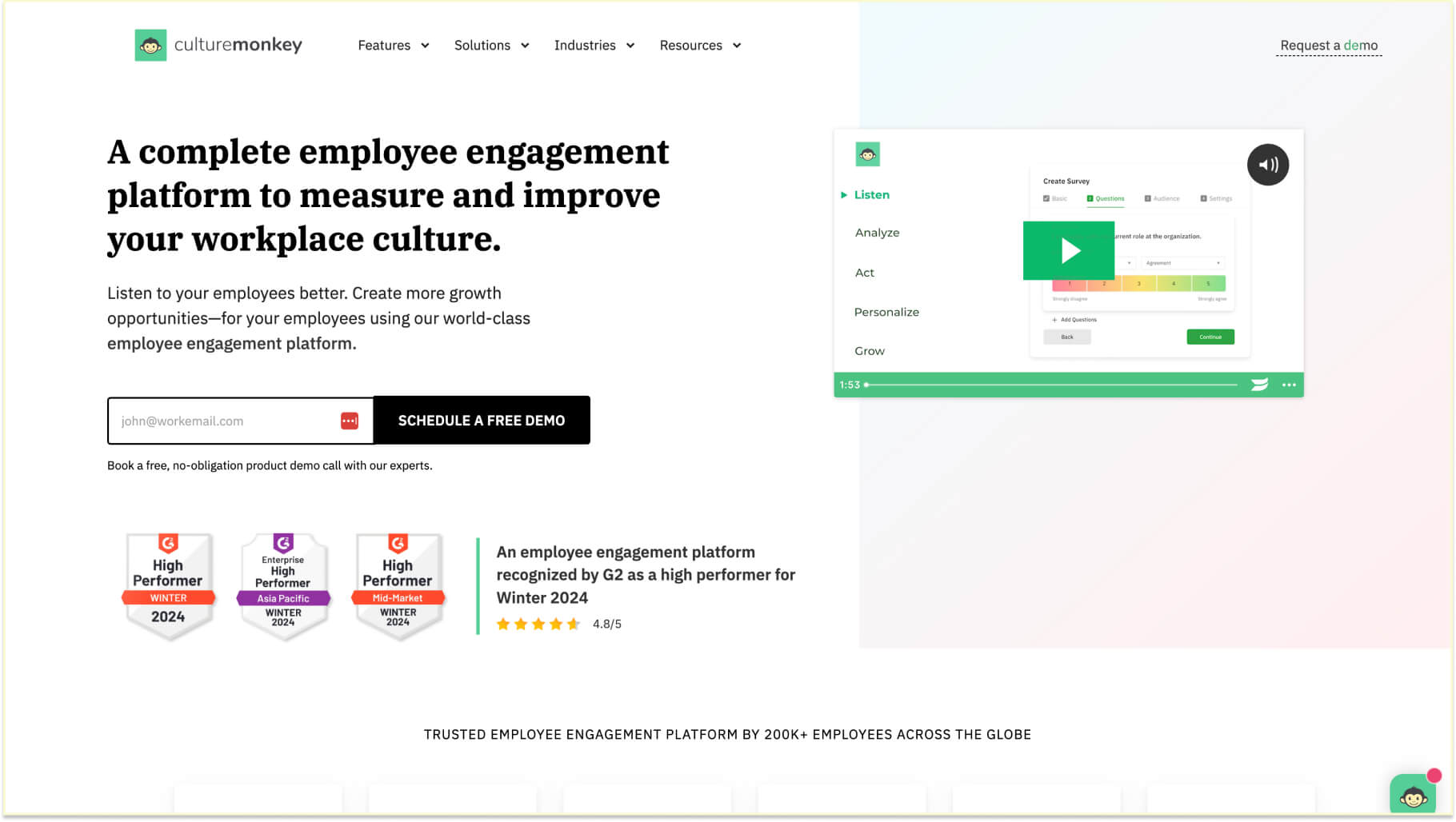
About CultureMonkey: CultureMonkey is an employee engagement platform designed to help organizations automate and personalize engagement surveys throughout the employee lifecycle. The platform offers 50+ research-backed survey templates and focuses on reducing survey fatigue through short pulse surveys that maximize participation. CultureMonkey stands out with its advanced dashboards, manager-level analytics, and action planning capabilities that actively involve stakeholders in improving engagement across the organization.
CultureMonkey main features:
- 50+ research-backed survey templates for various engagement needs
- Automated pulse surveys with customizable frequency
- Advanced dashboards with customization by manager level, location, department, and role
- Multi-channel survey delivery (WhatsApp, Slack, SMS, Teams)
- Real-time analytics with heat maps and engagement driver tracking
- Anonymous feedback with text analysis capabilities
- Lifecycle surveys from onboarding to exit
CultureMonkey pricing: Pricing is not listed on the website. To learn more about pricing, you'll need to schedule a demo/sales call with CultureMonkey.
CultureMonkey G2 score: CultureMonkey has a G2 score of 4.7/5 based on user reviews.
What CultureMonkey customers are saying on G2: “Culture Monkey has the most advanced dashboards that I have come across in a lot of tools that i have evaluated or worked with in the past. There are customized reports and views available, split by manager level, locations, departments and roles. The best feature is the manager-level cuts and the action planning where we can actively involve stakeholders and make them a part of the solution to improve engagement scores across the org.” - Palavi D., Mid-Market (G2 Review for CultureMonkey).
3. TINYpulse
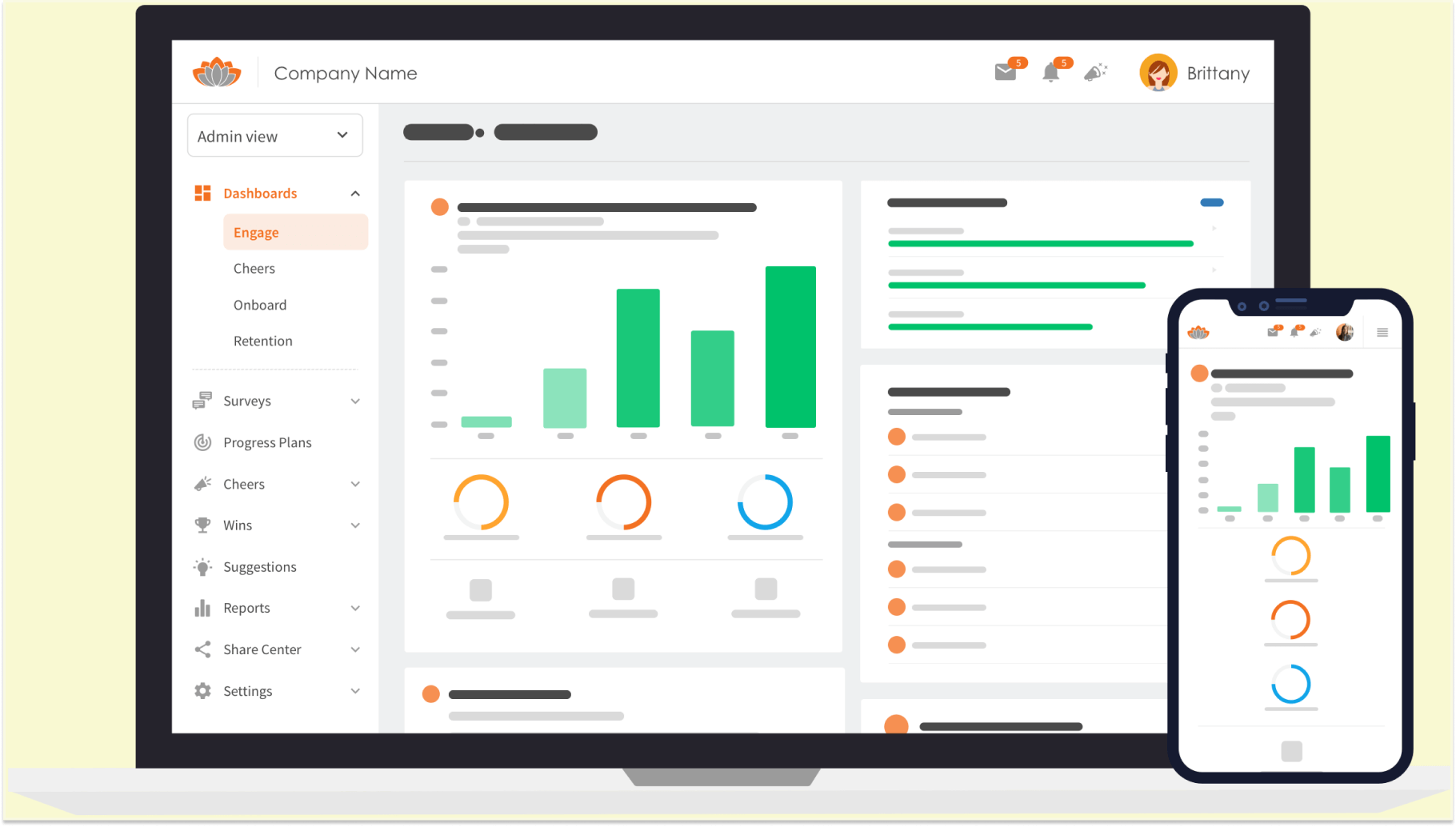
About TINYpulse: TINYpulse is an employee engagement platform that combines pulse surveys, peer recognition, and feedback tools to help organizations maintain a pulse on employee sentiment. The platform emphasizes simplicity with its signature one-question weekly surveys and provides tools for both upward and peer feedback.
TINYpulse main features:
- One-question weekly pulse surveys
- Peer recognition features (Cheers for Peers)
- Anonymous suggestion box
- Engagement metrics and trend analysis
TINYpulse pricing: Pricing is not listed on the website. To learn more about pricing, you'll need to schedule a demo/sales call with TinyPulse.
TINYpulse G2 score: TINYpulse has a G2 score of 4.9/5 based on user reviews.
What TINYpulse customers are saying on G2: “Its unfair to the unanonymous effect, its tied through email in our company. so what we think is not known, truly it is by the supervisors. so there isn't anything anonymous.” - Kayla S., Clerical Assistant.
4. 15Five
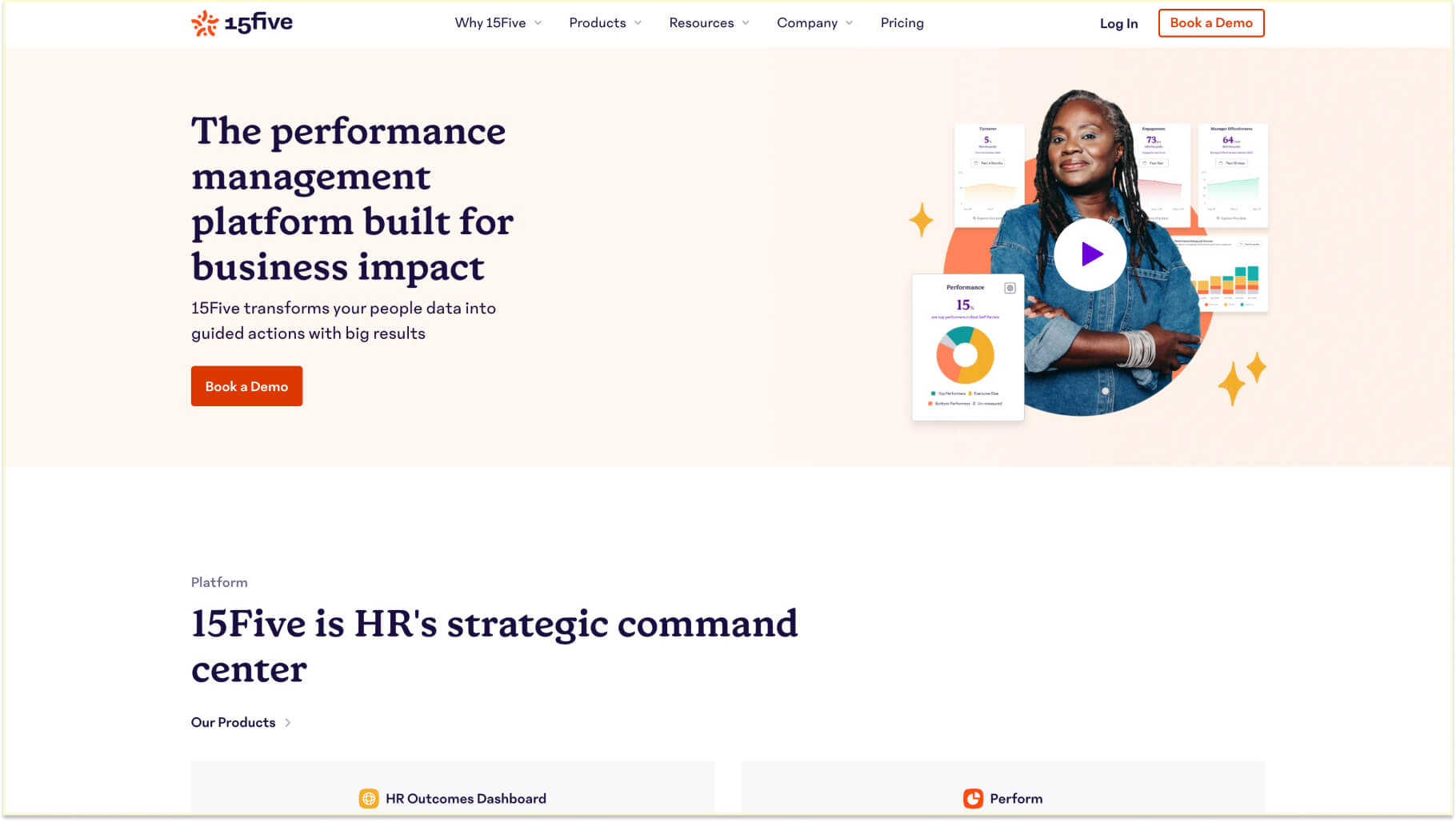
About 15Five: 15Five is a performance management platform that is fully incorporated and incorporates pulse surveys, weekly check-ins, OKR monitoring, and one-on-one tools to establish a comprehensive approach to employee engagement and development. The platform enables organizations to integrate regular feedback with performance conversations.
15Five main features:
- Weekly check-ins and pulse surveys
- Performance reviews and OKR tracking
- One-on-one meeting agendas
- Engagement metrics and analytics
15Five pricing:
- Engage: $4/user/month, billed annually
- Perform: $11/user/month, billed annually
- Total Platform: $16/user/month, billed annually
To learn more, view 15Five's pricing page.
15Five G2 score: 15Five has a G2 score of 4.6/5 based on user reviews.
What 15Five customers are saying on G2: “We have built a company wide OKR tied to our company wide average Pulse score. It is an easy check of how the company is "feeling" from week to week, and over the last 2 years, I have found it to be accurate, important and super easy for the team to adopt and stay consistent in use.”- Dan A., Small-Business (G2 Review for 15Five).
Small business pulse survey tools typically emphasize ease of use and quick time-to-value. These platforms recognize that smaller HR teams require solutions that demand minimal training and maintenance, while still delivering insights that enhance retention and engagement. Many offer free trials or freemium versions that allow organizations to test pulse surveys before committing to paid plans, reducing the risk of selecting a platform that doesn't match their needs.
Integration capabilities matter even for small businesses, particularly connections with communication tools like Slack or Microsoft Teams, where employees already spend a significant amount of time. When pulse surveys arrive through familiar channels, participation rates increase because employees don't need to remember separate platforms or log in with multiple passwords. Some small business tools also include features for peer-to-peer recognition, combining feedback collection with appreciation mechanisms that reinforce positive culture.
Specialized employee engagement pulse survey tools with advanced analytics
Beyond general-purpose platforms, specialized pulse survey tools focus on specific dimensions of employee experience or offer unique analytical capabilities that standard solutions lack. These platforms serve organizations with particular measurement priorities or those seeking competitive advantages through sophisticated people analytics. Specialized tools often incorporate artificial intelligence, predictive modeling, or behavioral science principles that go beyond basic survey administration.
Notable specialized pulse survey platforms:
1. Matter
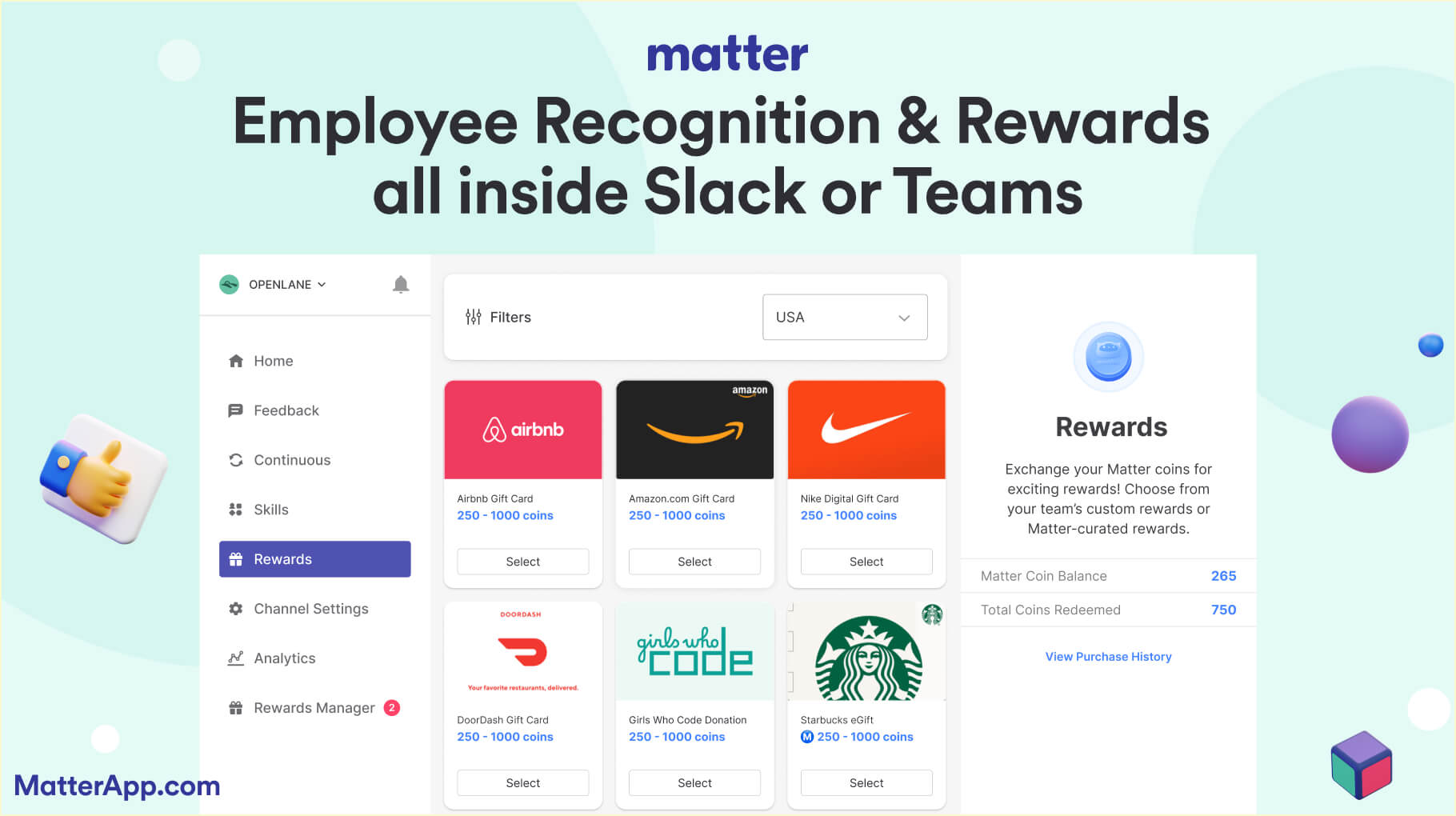
About Matter: Matter offers specialized analytics capabilities that bridge the gap between pulse survey data and recognition patterns, helping organizations understand whether their appreciation efforts actually impact employee engagement scores. The platform's unique analytical approach correlates recognition activity with engagement trends through advanced reporting, identifying which teams receive consistent recognition and which may be overlooked.
This directly addresses common pulse survey findings that employees often feel undervalued, while revealing which company values are celebrated most frequently. The analysis assesses whether the recognition culture aligns with stated organizational priorities.
Matter main features:
- Recognition analytics correlating with engagement metrics
- Value alignment tracking showing celebrated company values
- Team-level insights identifying recognition gaps from pulse surveys
- Trend analysis connecting appreciation frequency with employee sentiment
Matter pricing:
- Free Forever: $0/user/month
- Basic: $1/user/month, billed annually
- Pro: $3/user/month, billed annually
- Pro + Surveys: $5/user/month, billed annually
To learn more, view Matter's pricing page.
Matter G2 score: Matter has a G2 score of 4.7/5 based on user reviews.
What Matter customers are saying: "Being a high-performance team, Matter helps us take a moment out of our busy day to share heartfelt gratitude with kudos." - Sam Udotong, CTO & Co-founder at Fireflies.ai (Customer Story).
2. Workday

About Workday: Workday is an employee engagement platform that employs machine learning and intelligent surveys to offer real-time insights into employee sentiment. The platform automatically prioritizes issues and provides personalized recommendations for managers to take action.
Workday main features:
- AI-powered survey questions that adapt based on responses
- Real-time engagement scoring and analytics
- Automated insights and recommendations
- Manager dashboards with action guidance
Workday pricing:
- Workday Adaptive Planning: Free for 30 days
- Workday Adaptive Planning: contact sales to request pricing
- Workday Adaptive Planning Close & Consolidation: contact sales to request pricing
To learn more, view Workday’s pricing page.
Workday G2 score: Workday has a G2 score of 4.0/5 based on user reviews.
What Workday customers are saying on G2: “I've found Workday to be a reliable application for handling holiday and HR activities at my company. Its user-friendly interface makes requesting leave and checking balances easy and efficient. Real-time updates ensure I always know my leave status without chasing paperwork. I appreciate the integration with other HR functions, which provides a central hub for important information. While there can be some lag during busy times, overall, Workday simplifies holiday management and enhances transparency for both employees and HR teams.” - Saurabh Y., Senior Engineer (G2 Review for Workday).
3. Lattice
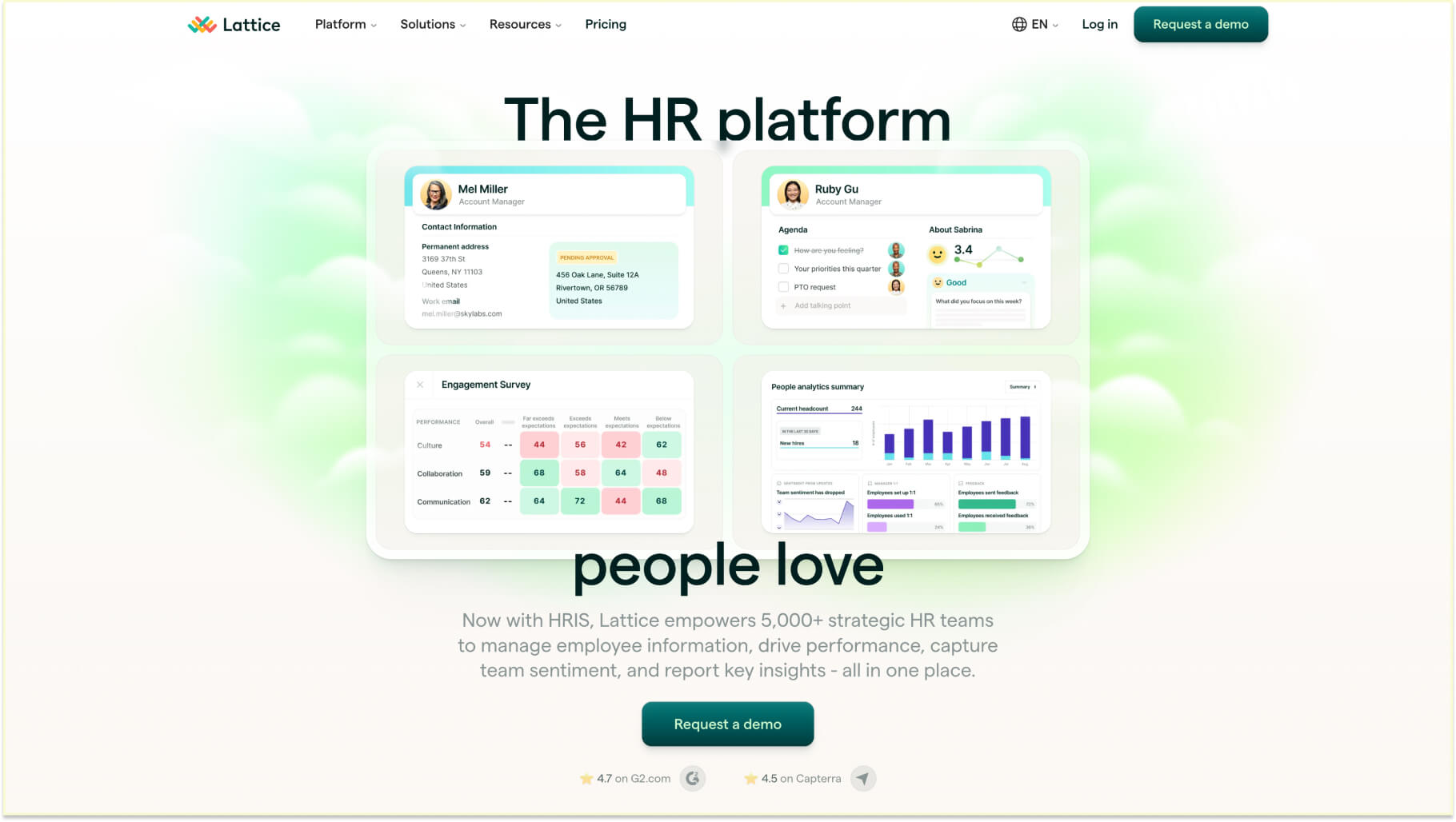
About Lattice: Lattice is a platform for managing people that integrates tools for career development, employee engagement, and performance management. The platform integrates pulse surveys with performance reviews, goals, and growth plans to provide comprehensive views of employee experience and development.
Lattice main features:
- Pulse surveys and engagement tools
- Performance reviews and continuous feedback
- Goals and OKR tracking
- Career development and growth planning
Lattice pricing:
- Talent Management: $11/seat/month
- Foundation: $11/seat/month
- Engagement: $4/seat/month
- Grow: $4/seat/month
- Compensation: $6/seat/month
To learn more, view Lattice’s pricing page.
Lattice G2 score: Lattice has a G2 score of 4.7/5 based on user reviews.
What Lattice customers are saying on G2: “Ease of use and ease of implementation. The implementation time commitment was hours not weeks. We initially implemented all modules except Grow, Comp, and Engage and manged to configure and test all modules in less than two weeks. The product team is very receptive to feedback and also able to help come up with creative workarounds for functional gaps. The customer support is great and very responsive.” - Matthew H., Senior Human Resources Manager (G2 Review for Lattice).
4. Leapsome

About Leapsome: Leapsome is an all-in-one people enablement platform that combines performance management, employee engagement, learning, and development. The platform integrates pulse surveys with goals, reviews, and learning paths to create comprehensive employee experience programs.
Leapsome main features:
- Employee engagement surveys and pulse checks
- Performance reviews and 360-degree feedback
- Learning and development tools
- Goals and OKR management
Leapsome pricing: Pricing is not listed on the website. To learn more about pricing, you'll need to schedule a demo/sales call with Leapsome.
Leapsome G2 score: Leapsome has a G2 score of 4.9/5 based on user reviews.
What Leapsome customers are saying on G2: “It is step to step process implementation of sales pattern , customer support , and a lot of feature to understand customer need .It also help to ease of interagtion customer mindset and win situation .It have a good dashboard GUI to understand also support avilable in a single call , once again thank you team leapsome because i was a layman and after half an hour training i became super user.” - SUMIT KUMAR O., Senior Technical Sales Engineer (G2 Review for Leapsome).
Specialized platforms often provide industry-specific question sets and benchmarks, enabling organizations to compare their pulse survey results with those of similar companies. This context helps leaders understand whether their scores indicate serious concerns or reflect normal patterns for their sector. Some tools also use natural language processing to analyze open-ended responses at scale, identifying themes and sentiment in qualitative feedback that might otherwise require hours of manual review.
Organizations implementing engagement surveys through specialized platforms gain advantages in connecting feedback to business outcomes. By linking pulse survey data with performance indicators, turnover rates, or customer satisfaction scores, these tools help demonstrate the ROI of engagement initiatives. This capability proves particularly valuable when seeking leadership buy-in for programs that enhance employee experience, as it quantifies the relationship between employee satisfaction and business performance.
The choice between general and specialized pulse survey software depends on an organization's maturity in people analytics and its specific measurement objectives. Companies beginning their pulse survey journey often benefit from straightforward platforms that make regular feedback collection easy and sustainable. As programs mature and organizations develop more sophisticated questions about their workforce, specialized tools provide the advanced capabilities needed to extract maximum value from employee feedback.
How to implement effective pulse survey programs step-by-step
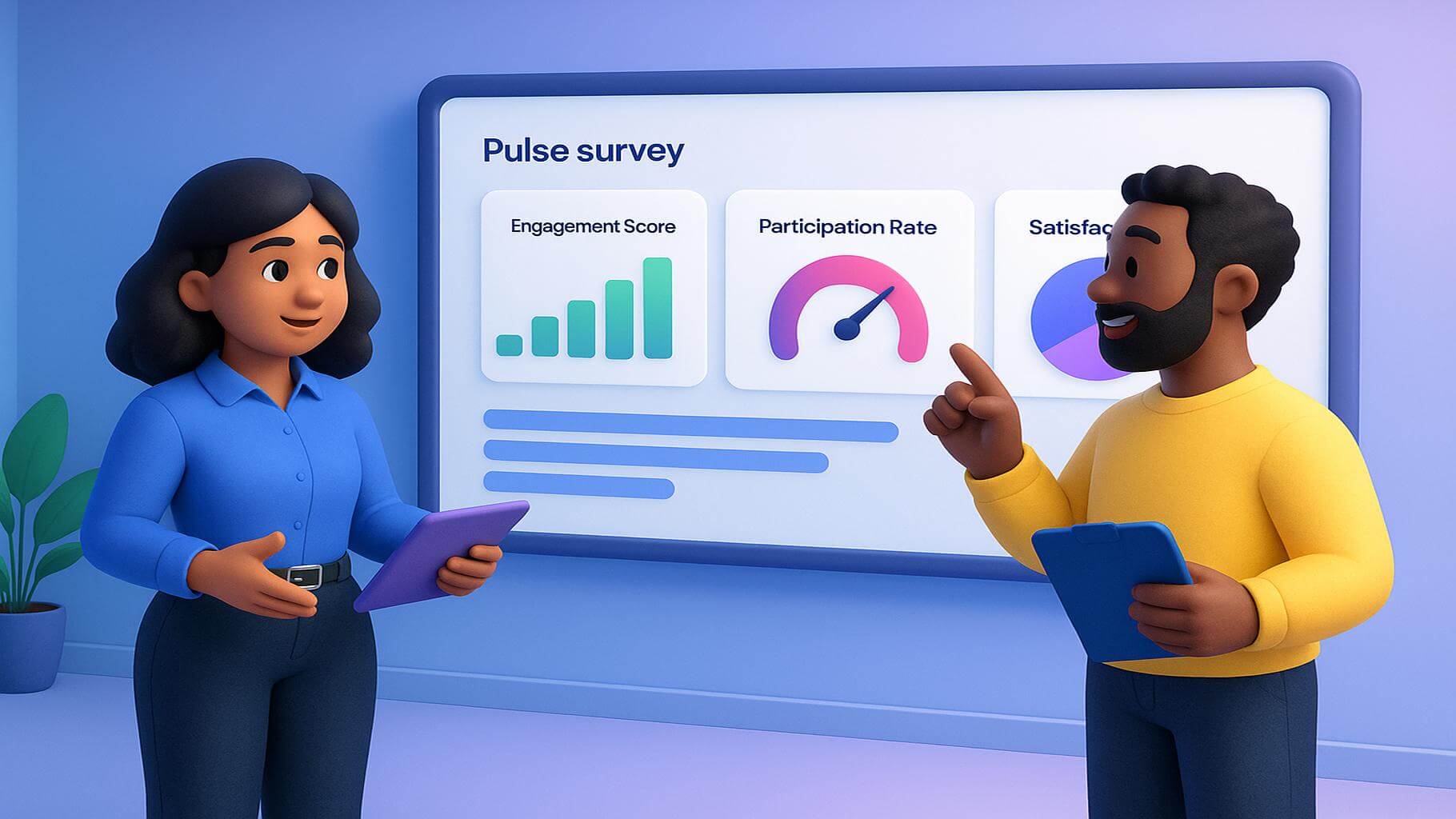
Successful pulse survey implementation requires thoughtful planning that addresses technical setup, communication strategy, and long-term sustainability. Organizations that treat pulse surveys as isolated data collection exercises often experience declining participation rates and a limited impact on employee engagement. In contrast, companies that integrate pulse surveys into broader feedback cultures while demonstrating consistent action on results create virtuous cycles where employees increasingly trust that their input drives meaningful change.
The implementation process begins with clarifying objectives and designing a pulse survey strategy aligned with organizational priorities. Leaders must decide on survey frequency, question selection, communication approaches, and, most importantly, how they will convert pulse survey insights into action plans. Without this foundational planning, even perfectly executed surveys fail to deliver value because organizations lack processes for responding to what employees share.
Setting up automated pulse survey schedules for optimal response rates
Automation transforms pulse surveys from administrative burdens into sustainable feedback mechanisms that run consistently without requiring constant manual intervention. Modern pulse survey software allows organizations to schedule recurring surveys, automatically distribute invitations through preferred channels, and send reminders to non-responders. This automation ensures pulse surveys occur on a regular cadence regardless of competing priorities or personnel changes within HR teams.
Key elements of effective pulse survey automation:
- Consistent timing: Send surveys on the same day and time each cycle, so employees anticipate and prepare for providing feedback
- Smart reminders: Configure systems to send one or two gentle reminders to employees who haven't completed surveys, typically 24-48 hours after initial distribution
- Channel optimization: Deliver pulse surveys through the communication tools employees already use daily, such as email, Slack, or Microsoft Teams
- Mobile accessibility: Ensure surveys work seamlessly on smartphones and tablets, since many employees prefer completing short surveys on mobile devices
- Seasonal considerations: Adjust automated schedules around holidays, busy periods, or major organizational events when participation might suffer
Organizations should start with a modest survey frequency and increase it gradually based on response patterns and their capacity to act on feedback. Many companies find that biweekly or monthly pulse surveys strike the right balance between gathering timely insights and avoiding survey fatigue. The goal is to maintain consistent feedback without overwhelming employees or creating expectations for action that the organization cannot meet.
When implementing pulse surveys, consider the time zones of distributed teams and the work schedules of shift workers or field employees. Automation should accommodate these differences by sending surveys when employees are most likely to engage, rather than using a one-size-fits-all approach to timing. Some platforms allow personalized delivery schedules that respect individual work patterns, increasing the likelihood that employees will complete pulse surveys thoughtfully rather than rushing through to meet deadlines.
Integrating pulse surveys with employee incentive programs can boost participation, though organizations should avoid creating situations where employees provide dishonest answers solely to receive rewards. The focus should remain on making feedback meaningful and demonstrating that employee input influences decisions, which proves more effective than external incentives in sustaining engagement with pulse survey programs over time.
Creating psychological safety for honest pulse survey feedback
Employees share honest answers only when they trust that doing so won't result in negative consequences. Building this psychological safety requires clear communication about anonymity protections, visible leadership commitment to hearing difficult truths, and demonstrated patterns of responding constructively to critical feedback. Without these elements, pulse surveys collect sanitized responses that fail to surface the real issues affecting employee engagement and organizational health.
Strategies for building trust in pulse survey processes:
- Guarantee anonymity: Use pulse survey platforms with technical safeguards that prevent identifying individual respondents, and communicate these protections clearly
- Aggregate reporting: Establish minimum group sizes for reporting results to prevent identification through demographic filtering or small team sizes
- Leadership modeling: Have senior leaders share their own feedback publicly and acknowledge areas where the organization needs improvement
- Respond to criticism: When pulse surveys reveal problems, thank employees for their honesty rather than becoming defensive or dismissive.
Organizations should acknowledge that building psychological safety around pulse surveys takes time, especially in cultures where employees have previously experienced retaliation for speaking up. Initial pulse survey results may not fully reflect employee sentiment if trust remains low. As organizations consistently demonstrate that they act on feedback without seeking to identify critics, participation rates and response candor typically improve over subsequent survey cycles.
Some organizations supplement anonymous pulse surveys with opportunities for employees to provide feedback when they choose to do so. This hybrid approach acknowledges that some employees value recognition for constructive suggestions, while others require anonymity to share concerns about managers or leadership. Offering both options respects different comfort levels while maximizing the valuable insights organizations receive from employees across the confidence spectrum.
Creating cultures where employees feel safe providing feedback extends beyond pulse surveys to everyday interactions. When managers respond defensively to criticism or discount employee concerns, it undermines trust in formal feedback mechanisms regardless of technical anonymity protections. Organizations committed to honest pulse survey feedback must develop management capabilities around receiving and acting on difficult information constructively, a broader cultural shift that pays dividends across multiple dimensions of employee experience.
Integrating pulse survey data with performance management systems
The most valuable pulse survey programs connect employee feedback with other people's data, creating comprehensive views of organizational health and workforce performance. Integrating pulse survey results with performance management systems allows organizations to understand relationships between engagement, productivity, development, and retention. These connections enable leaders to determine whether engagement initiatives yield business outcomes and which interventions deliver the strongest returns on investment.
Integration opportunities for pulse survey data:
- Performance correlations: Analyze whether teams with higher engagement scores also demonstrate stronger performance against objectives
- Development planning: Use pulse survey feedback about career growth to inform professional development opportunities and succession planning
- Manager effectiveness: Connect team-level pulse survey results with manager performance evaluations to incentivize leadership behaviors that drive engagement
- Retention prediction: Combine pulse survey data indicating job satisfaction with other signals to identify employees at risk of leaving
Many modern HRIS platforms and performance management tools offer APIs that enable data sharing with pulse survey software. This integration enables HR teams to create unified dashboards that present workforce insights holistically, eliminating the need for manual effort to combine information from disparate systems. When data flows seamlessly between platforms, organizations can spot patterns and take action more quickly than when pulse survey results exist in isolation.
Organizations should approach integration thoughtfully, ensuring that connecting pulse survey data with performance systems doesn't compromise anonymity or create perceptions that feedback influences performance ratings. The goal is to understand patterns and relationships at the team or organizational level, not to evaluate individuals based on their survey responses. Clear communication about how data will and won't be used protects the psychological safety essential for honest feedback.
By linking pulse surveys with employee rewards programs, organizations can ensure recognition reaches employees who might otherwise feel under-appreciated. If pulse survey data reveals that certain teams feel less recognized than others, targeted appreciation initiatives can address these gaps. This responsive approach demonstrates that organizations take feedback seriously and translate insights into concrete actions that enhance the work experience for employees.
Analyzing and acting on pulse survey results for meaningful change

Collecting pulse survey data represents only the first step in creating value from employee feedback. The real impact comes from thoughtful analysis that identifies priorities and the development of action plans that address what employees have shared. Organizations that excel at pulse surveys invest as much energy in responding to feedback as they do in collecting it, recognizing that employee trust in future surveys depends entirely on whether they see meaningful responses to previous input.
Effective analysis goes beyond reviewing overall scores to identify specific areas requiring attention and understanding which interventions might yield the greatest improvements. This requires examining data at multiple levels, from organizational trends to team-specific patterns, and connecting quantitative ratings with qualitative comments that provide context. The goal is to transform raw pulse survey results into clear priorities that guide resource allocation and leadership focus.
Identifying trends and patterns in employee pulse survey responses
Sophisticated analysis of pulse survey data reveals patterns that single snapshots might miss. By tracking responses over time, organizations can identify whether engagement improves or declines, which initiatives correlate with positive changes, and where persistent challenges persist despite improvement efforts. This longitudinal view helps leaders distinguish between temporary fluctuations and meaningful trends that warrant strategic responses.
Analytical approaches for pulse survey data:
- Trend analysis: Compare current results with previous pulse survey cycles to identify improving or declining areas
- Segmentation: Examine responses by department, location, tenure, or role to understand whether experiences vary across employee groups
- Correlation analysis: Identify relationships between different metrics, such as whether recognition scores predict overall engagement levels
- Comment analysis: Review open-ended responses for themes that explain quantitative patterns or surface issues not addressed by structured questions
Organizations should establish regular review cadences where leadership teams examine pulse survey results, typically within one to two weeks of survey completion. This prompt analysis signals that leadership values employee feedback and considers it important enough to prioritize despite competing demands. Delayed analysis creates perceptions that pulse surveys serve bureaucratic rather than improvement purposes, undermining future participation.
When analyzing pulse survey data, resist the temptation to focus exclusively on negative results. While problems certainly require attention, identifying and celebrating areas where scores are strong or improving provides equally valuable insights. Understanding what works allows organizations to replicate successful practices across teams and reinforces positive trends. Balanced analysis acknowledges both challenges and successes, creating a more comprehensive picture of organizational health.
Some patterns in pulse survey results might initially seem concerning, but reflect expected experiences for specific employee segments. For example, new hires often report lower engagement in their first months as they acclimate to roles and organizations. Understanding these normal patterns prevents overreactions while ensuring genuine problems receive appropriate attention. Benchmarking against external data or historical internal baselines provides context that makes pulse survey results more interpretable and actionable.
Converting pulse survey insights into actionable improvement plans
Insight without action damages employee trust more than never asking for feedback. After identifying priorities through pulse survey analysis, organizations must develop concrete action plans with clear owners, timelines, and success metrics. These plans should address root causes rather than symptoms, focusing on changes that genuinely improve the employee experience rather than superficial responses that merely check boxes without solving problems.
Framework for developing pulse survey action plans:
- Prioritize focus areas: Select two to three issues where action will have the greatest impact rather than trying to address everything simultaneously.
- Involve employees: Create working groups that include employees affected by issues to co-design solutions rather than imposing top-down fixes.
- Define specific actions: Translate general themes into concrete steps with assigned responsibilities and target completion dates.
- Communicate plans: Share what organizations learned from pulse surveys and what actions they will take in response, including timelines for implementation.
- Track progress: Monitor whether actions occur as planned and whether subsequent pulse surveys show improvement in targeted areas
Organizations should communicate transparently about what they can and cannot address based on the feedback from pulse surveys. Sometimes, employee concerns relate to factors outside of organizational control or require resources that are not currently available. Honest communication about constraints preserves trust better than making commitments that leadership knows cannot be fulfilled. When organizations must decline addressing certain feedback, explaining the reasons and alternative actions demonstrates respect for employee input.
Successful action planning often requires investment beyond HR initiatives. If pulse surveys reveal concerns about professional development opportunities, effective responses may involve allocating a budget for training, dedicating time for participation, or revising career path frameworks. When pulse survey results indicate workload concerns, solutions might require staffing increases, process improvements, or priority adjustments rather than engagement programming. This reality means that acting on pulse surveys requires enterprise-wide commitment rather than treating feedback as solely an HR responsibility.
Connecting action plans to recognition awards or appreciation can reinforce desired behaviors and celebrate teams that successfully implement improvements based on employee feedback. This approach fosters positive associations with the pulse survey process while providing concrete examples of how employee input drives organizational growth and evolution.
Measuring the ROI of pulse survey initiatives on employee engagement
Demonstrating value from pulse survey investments requires connecting feedback programs to meaningful business outcomes. Organizations measure ROI by tracking whether engagement improvements correlate with reduced turnover, increased productivity, enhanced customer satisfaction, or other relevant organizational metrics specific to their industry and strategic priorities. This quantification helps secure ongoing investment in employee experience while validating that pulse surveys contribute to business success rather than simply creating busy work for HR teams.
Metrics for evaluating pulse survey program effectiveness:
- Participation trends: Increasing response rates over time signal growing employee trust in the feedback process
- Engagement score changes: Improvements in key engagement metrics demonstrate that action plans effectively address employee concerns.
- Retention impact: Compare turnover rates for high versus low engagement teams to quantify the relationship between sentiment and retention
- Business performance: Analyze whether teams with improving engagement scores also show enhanced performance against relevant KPIs
- Implementation tracking: Monitor what percentage of action plans derived from pulse surveys achieve completion within target timeframes
Organizations should set realistic expectations about how quickly pulse survey initiatives impact outcomes. Cultural changes and engagement improvements typically unfold over quarters or years rather than weeks, requiring patience and persistence. Early wins might include increased participation rates or positive employee reactions to transparency about results rather than dramatic shifts in engagement scores. Celebrating these incremental victories maintains momentum for longer-term transformation.
Some benefits of pulse survey programs resist precise quantification but still deliver significant value. The relationships built between managers and employees through regular check-ins, the cultural shifts toward transparency and psychological safety, and the skill development among leaders learning to act on feedback all contribute to organizational health in ways that spreadsheets might not fully capture. While maintaining focus on measurable outcomes, organizations should also recognize these intangible returns from investments in employee voice and feedback culture.
By aligning pulse surveys with staff rewards, organizations can demonstrate immediate responsiveness to feedback while fostering cultures where recognition naturally flows from observed contributions. This combination of listening and acknowledging creates powerful employee experiences that drive loyalty and performance even before larger organizational changes can be implemented.
Common pulse survey mistakes and how to avoid them

Even well-intentioned pulse survey programs can fail to deliver value when organizations make common implementation errors. Understanding these pitfalls helps HR leaders design more effective feedback processes from the outset while avoiding predictable problems that undermine employee trust and program sustainability. Most pulse survey mistakes stem from treating feedback collection as the goal rather than as the means to create meaningful improvements in how employees experience work.
Organizations new to pulse surveys often focus heavily on technical aspects, such as platform selection and question design, while underinvesting in the cultural and operational changes necessary for success. The most sophisticated pulse survey software cannot overcome cultures that lack psychological safety or organizational structures that prevent employees from acting on their input. Avoiding common mistakes requires equal attention to technology, communication, and organizational readiness for feedback-driven change.
Why generic pulse survey questions fail to drive engagement
Many organizations start pulse survey programs by borrowing questions from templates or competitors without considering whether these items align with their specific challenges and priorities. Generic questions produce generic insights that fail to guide targeted action. When employees don't see connections between their feedback and subsequent organizational changes, they disengage from future surveys, regardless of the quality of the questions or the anonymity protections.
Problems with one-size-fits-all pulse survey approaches:
- Irrelevant content: Questions about issues the organization has already addressed or cannot influence waste employees' time and signal a lack of thoughtfulness
- Missing priorities: Generic surveys might overlook topics critical to specific organizational contexts, failing to surface the insights leaders most need
- Vague findings: Broad questions produce equally broad results that don't point toward specific actions or improvements
- Disengagement: Employees recognize when organizations put minimal effort into question design and reciprocate with minimal engagement
Effective pulse surveys strike a balance between standard questions that enable trend tracking and rotating items tailored to current organizational priorities. This approach maintains some consistency for longitudinal analysis while ensuring each survey feels relevant to employees' immediate experiences. Organizations should regularly review and refresh their pulse survey questions, removing items that no longer provide value and adding questions that address emerging challenges or new initiatives.
Customization also means adapting language and examples to organizational contexts. Questions about "clients" versus "customers," "projects" versus "production," or "teams" versus "departments" should reflect how employees actually describe their work. These small adjustments enhance question clarity and demonstrate that pulse surveys were designed specifically for the organization, rather than being downloaded from generic templates.
Some organizations involve employees in the development of questions through focus groups or pilot testing. This participatory approach ensures questions resonate with how employees think about their experience while building investment in the pulse survey process. When employees helped shape what organizations ask, they feel greater ownership of providing thoughtful responses and holding leadership accountable for addressing what surveys reveal.
Avoiding survey fatigue while maintaining regular feedback cycles
Survey fatigue represents one of the greatest threats to sustainable pulse survey programs. When organizations ask for feedback too frequently, send surveys that are too long, or fail to demonstrate responsiveness to previous input, employees disengage from the process. Declining participation rates signal that survey fatigue has taken hold, requiring organizations to recalibrate their approach before trust erodes completely.
Strategies to prevent survey fatigue in pulse programs:
- Respect time: Keep pulse surveys to 5-10 questions that employees can complete in three to five minutes
- Show impact: Communicate what changed based on previous pulse survey results before asking for new feedback
- Rotate topics: Avoid asking identical questions every cycle unless tracking specific metrics; vary content to maintain interest.
- Consolidate feedback: Coordinate across departments to prevent employees from receiving multiple surveys simultaneously from different organizational units.
- Allow opt-outs: Let employees skip occasional pulse surveys without pressure, recognizing that survey timing might conflict with work demands.
Organizations should monitor participation rates closely as early indicators of survey fatigue. When response rates decline gradually over several cycles, it signals that adjustments are necessary before the program loses credibility. Common interventions include reducing frequency, shortening surveys, improving communication about actions taken, or temporarily pausing to reset expectations and rebuild engagement.
The quality of responses matters as much as quantity. Even if participation rates remain stable, organizations should watch for signs that employees rush through pulse surveys without thoughtful engagement. The increasing selection of neutral middle options, declining completion of optional open-ended questions, or patterns suggesting that respondents select options randomly, all indicate that survey fatigue has degraded data quality, even when people technically complete surveys.
Balancing pulse survey frequency with other feedback mechanisms prevents over-reliance on any single tool. Organizations might combine monthly pulse surveys with quarterly skip-level meetings, annual comprehensive engagement surveys, and ongoing one-on-one conversations between managers and employees. This diversified feedback ecosystem reduces the burden on pulse surveys to accommodate all listening requirements, while simultaneously offering employees numerous opportunities to express their viewpoints.
Ensuring pulse survey anonymity and building employee trust
Anonymity concerns represent significant barriers to honest feedback, particularly in smaller organizations or teams where demographic filtering may enable the identification of respondents. When employees worry that leadership could trace critical feedback back to them, they provide sanitized responses that defeat the purpose of pulse surveys. Building and maintaining robust anonymity protections requires a combination of technical safeguards and cultural norms that value dissenting voices rather than punishing them.
Essential elements of pulse survey anonymity:
- Technical protection: Use pulse survey platforms that don't store identifying information with response data and prevent IP address tracking
- Aggregation thresholds: Only report results when response groups exceed minimum sizes that prevent identification through the process of elimination
- Communication clarity: Explain exactly what anonymity protections exist and what limitations apply so employees can make informed decisions about candor
- Leadership commitment: Have senior leaders explicitly endorse honest feedback and commit to responding constructively rather than seeking to identify critics
Some organizations struggle with the tension between anonymity and accountability for their actions. Leaders legitimately want to address team-specific issues but cannot do so without knowing which teams reported problems. The solution involves finding appropriate aggregation levels where teams are large enough to preserve anonymity while still receiving actionable feedback. For very small teams, organizations might only share organizational-level results while leaders conduct follow-up conversations to understand local dynamics.
Transparency about anonymity limitations builds trust more effectively than over-promising protections that technical realities cannot support. If organizational size means that certain demographic combinations could identify individuals, communicate this honestly rather than claiming absolute anonymity. Employees appreciate authenticity and can make informed choices about what feedback to share through anonymous channels versus other mechanisms when they understand real constraints.
Over time, as organizations demonstrate consistent patterns of responding constructively to critical feedback, employees often become more willing to share honest answers even with imperfect anonymity. Trust builds gradually through repeated positive experiences where employees see that leadership welcomes difficult truths and invests in addressing problems that surveys reveal. This cultural foundation ultimately matters more than technical features in determining whether pulse surveys surface the insights organizations need to improve employee experience.
FAQs about pulse surveys

Q: What is a pulse survey, and how often should companies conduct them?
A: A pulse survey is a short, frequent questionnaire that measures employee sentiment on specific workplace topics. Most organizations conduct pulse surveys on a weekly, biweekly, or monthly basis, depending on their size and capacity to act on feedback. The ideal frequency balances gathering timely insights with avoiding survey fatigue, typically ranging from every two weeks to once per month.
Q: What are the most effective pulse survey questions for measuring employee engagement?
A: The most effective pulse survey questions focus on key engagement drivers like job satisfaction, manager support, recognition, career development, and organizational confidence. At least one open-ended question should be included, allowing employees to elaborate on their experiences, and the questions should be phrased in clear language with rating scales spanning from 'strongly disagree' to' strongly agree'. Rotate questions to cover different engagement dimensions rather than asking identical items every cycle.
Q: How do pulse survey tools integrate with existing HR systems and workflows?
A: Modern pulse survey software integrates with HRIS platforms, performance management systems, and communication tools through APIs and native integrations. These connections enable automated data sharing, unified reporting dashboards, and survey distribution through channels that employees already use, such as email, Slack, or Microsoft Teams. Integration reduces administrative burden while providing comprehensive views of workforce data.
Q: What's the difference between pulse surveys and traditional employee engagement surveys?
A: Traditional annual employee engagement surveys are comprehensive assessments with 50-80 questions covering all aspects of employee experience. Pulse surveys are brief, frequent check-ins with 5-15 targeted questions on specific topics. Annual surveys provide deep organizational snapshots, while pulse surveys enable real-time monitoring and faster response to emerging issues. Many organizations use both approaches complementarily.
Q: How can organizations improve pulse survey response rates and employee participation?
A: Improve participation by keeping surveys brief, sending them through familiar communication channels, demonstrating visible action on previous feedback, and building psychological safety around honest responses. Consistent timing, mobile accessibility, and clear communication about how feedback drives change all contribute to increased response rates. Most importantly, show employees that their input matters by implementing improvements based on pulse survey insights.
Q: What should companies do with pulse survey results to create meaningful change?
A: Analyze results promptly to identify priority areas, involve employees in co-designing solutions, develop specific action plans with clear owners and timelines, and communicate transparently about what will change based on feedback. Monitor whether actions are occurring as planned and whether subsequent pulse surveys indicate improvement in targeted areas. Close the feedback loop by sharing progress updates with employees who provided input.
How Matter can help with pulse surveys and employee feedback

While pulse surveys provide valuable insights into employee sentiment, organizations require comprehensive solutions that effectively connect feedback with actionable outcomes. Matter transforms how companies gather, understand, and respond to employee input by integrating recognition, feedback, and celebration into a seamless platform. This approach ensures that listening to employees leads directly to making them feel valued through meaningful appreciation and timely acknowledgment of their contributions.
Matter's Slack-first and Teams-first design brings recognition into the tools employees already use daily, making appreciation as natural as any other workplace conversation. The platform's automation features ensure that celebrations happen consistently without requiring constant manual effort from HR teams or managers. By combining feedback insights with recognition mechanisms, Matter helps organizations cultivate cultures where employees feel both heard and appreciated equally.
Integrating pulse survey insights with real-time recognition programs
Organizations that excel at employee engagement don't just collect feedback through pulse surveys but also respond immediately by recognizing employees who exemplify desired behaviors or overcome challenges. Matter enables this connection by making recognition simple and spontaneous. When pulse surveys reveal that certain teams feel under-appreciated, leaders can use Matter to increase recognition visibility for those groups, demonstrating immediate responsiveness to employee input.
How Matter enhances feedback-driven recognition:
- Customizable kudos cards: Create recognition aligned with company values or specific behaviors identified through pulse survey themes
- Automated reminders: Feedback Friday features ensure regular recognition habits that address appreciation gaps revealed in surveys
- Flexible rewards: Matter's coin-based system enables employees to select rewards that are meaningful to them, ranging from charitable donations to gift vouchers.
- Integration simplicity: Setup takes minutes with Slack and Teams, enabling organizations to act on pulse survey insights immediately
Matter's approach to workplace rewards complements pulse surveys by creating visible appreciation cultures. When employees see peers being recognized for contributions, it reinforces that the organization values those behaviors. This visible feedback loop enables organizations to demonstrate their commitment to acting on pulse survey insights, fostering positive cultures where appreciation flows naturally.
Automated celebration of pulse survey participation and improvements
Recognition shouldn't be limited to business achievements but should also celebrate employees' willingness to provide feedback and teams that demonstrate improved engagement scores. Matter automates these celebrations, ensuring that participation in pulse surveys receives appreciation and that progress on engagement metrics gets acknowledged. This approach reinforces the value organizations place on employee voice while motivating continued engagement with feedback processes.
Automated celebration features in Matter:
- Milestone recognition: Automatically celebrate work anniversaries and birthdays, addressing pulse survey feedback about insufficient personal acknowledgment
- Custom occasion alerts: Set up celebrations for team achievements or pulse survey participation milestones
- Self-serve date collection: Matter gathers important dates from employees directly, removing administrative burden
- Beautiful card options: Customizable templates, including inside jokes and personalized messages, make celebrations meaningful rather than generic.
By automating celebrations, Matter ensures consistency that manual processes cannot match. This reliability matters particularly when pulse surveys reveal that recognition feels sporadic or unfair. Automated systems treat everyone equally, celebrating milestones for all employees rather than only those remembered by busy managers. This consistency addresses common complaints about favoritism or exclusion from appreciation in pulse surveys.
Organizations can also use Matter to recognize employees who participate actively in pulse surveys or contribute valuable feedback through open-ended responses. This meta-recognition reinforces that employee voice matters and that thoughtful participation in feedback processes deserves appreciation alongside business accomplishments.
Using Matter's analytics to correlate recognition with engagement metrics
Understanding relationships between recognition patterns and engagement outcomes helps organizations optimize their appreciation strategies. Matter provides analytics that reveal who gives and receives recognition, which company values get celebrated most frequently, and how recognition patterns change over time. When combined with pulse survey data, these insights enable organizations to understand whether recognition initiatives effectively address the appreciation gaps identified by surveys.
Analytics capabilities that enhance pulse survey insights:
- Recognition trends: Track whether recognition frequency increases after pulse survey action plans target appreciation
- Value alignment: Monitor which company values receive recognition to ensure focus aligns with organizational priorities
- Participation patterns: Identify teams or individuals who might need encouragement to engage with recognition programs
- Impact measurement: Correlate recognition activity with subsequent pulse survey scores to quantify the appreciation's effect on engagement
Matter's analytics transform recognition from feel-good gestures into strategic interventions with measurable impact on employee experience. When pulse surveys reveal low recognition scores for certain departments, leaders can use Matter's data to verify whether those teams actually receive less appreciation or simply perceive recognition differently. These insights inform targeted interventions that address real gaps rather than relying on assumptions about what needs improvement.
The platform's reporting capabilities also help organizations demonstrate ROI from investing in recognition culture. By connecting Matter's recognition data with pulse survey improvements in engagement scores, HR leaders can quantify the contribution of appreciation programs to an enhanced employee experience. This proof point helps secure ongoing investment in recognition initiatives while validating that the time employees spend acknowledging each other delivers organizational value beyond warm feelings.
Final thoughts about pulse surveys and employee engagement
Pulse surveys represent powerful tools for understanding and improving the employee experience, but their value depends entirely on an organization's commitment to acting on what employees share. Companies that implement pulse surveys as compliance exercises or data collection projects waste both their own resources and employees' time. The organizations that succeed with pulse surveys treat them as catalysts for building cultures of continuous improvement where employee voice shapes how work happens and where people feel genuinely valued for their contributions.
The most effective pulse survey programs strike a balance between measurement and action, gathering insights while also demonstrating responsiveness through visible changes. This requires discipline to avoid the common trap of collecting endless data without implementing it. Organizations should remember that acting on some feedback proves more valuable than perfectly analyzing everything employees share. Speed matters because delayed responses signal that leadership doesn't truly prioritize employee input, regardless of what they say about valuing feedback.
Building a culture of continuous feedback beyond pulse surveys
Pulse surveys should complement rather than replace other feedback mechanisms. Organizations committed to employee voice create multiple channels where people can share their perspectives, ranging from one-on-one conversations with managers to anonymous suggestion systems and skip-level meetings with leadership. This diverse feedback ecosystem ensures that employees with different communication preferences all find ways to be heard. Some people thrive providing feedback through anonymous pulse surveys, while others prefer face-to-face conversations where they can discuss nuances.
Elements of comprehensive feedback cultures:
- Manager training: Develop leaders' capabilities to solicit, receive, and act on feedback during regular conversations
- Transparent communication: Share what organizations learn from all feedback channels and what actions result from employee input
- Psychological safety: Build cultures where people feel safe raising concerns without fear of negative consequences
- Accessible channels: Provide multiple options for sharing feedback so everyone finds mechanisms that match their comfort levels
The goal extends beyond collecting feedback to creating environments where continuous improvement happens naturally. When organizations develop strong feedback cultures, problems surface and get resolved before they escalate into issues that pulse surveys would detect. In the healthiest cultures, pulse surveys confirm what leaders already know from ongoing conversations rather than revealing surprising problems that leadership missed. This doesn't mean pulse surveys lose value; rather, they serve as quality checks on whether everyday feedback channels work effectively.
Organizations should also recognize that feedback culture requires reciprocity. Employees deserve feedback about their performance and development with the same regularity that organizations request input about the workplace experience. When feedback flows both directions freely, it strengthens relationships and reinforces that communication serves mutual growth rather than unidirectional evaluation.
Future trends in employee pulse survey technology and methodology
Pulse survey technology continues evolving, with artificial intelligence enabling more sophisticated analysis of open-ended responses and predictive analytics forecasting engagement risks before they manifest in turnover. Natural language processing can identify themes across thousands of qualitative comments that would take humans weeks to categorize manually. These technological advances enable organizations to extract richer insights from pulse survey data while reducing the analytical burden that sometimes prevents prompt action on feedback.
Emerging pulse survey innovations:
- Adaptive questioning: Surveys that adjust based on previous responses, diving deeper into areas where individuals express concerns
- Sentiment analysis: AI tools that assess tone and emotion in text responses, providing context beyond simple word frequency
- Predictive modeling: Algorithms that identify which factors most strongly predict retention or performance for specific organizations
- Integration ecosystems: Platforms that connect pulse survey data with productivity tools, communication patterns, and business metrics
Future pulse survey methodologies will likely focus more on measuring employee experience in real-time through ambient sensing, rather than relying solely on periodic survey snapshots. Some organizations experiment with passive data collection from communication tools, calendar patterns, and productivity metrics to supplement self-reported feedback. These approaches raise important privacy considerations but could provide continuous organizational health monitoring without requiring active employee participation in surveys.
The trend toward personalization will also shape the evolution of pulse surveys. Rather than administering identical surveys to all employees, future systems might customize questions based on individual roles, tenure, previous responses, or organizational initiatives relevant to specific employees. This personalization could enhance relevance and engagement, ensuring that each person's survey experience feels tailored to their actual workplace context.
Creating sustainable feedback loops that drive long-term engagement
Sustainability separates pulse survey programs that deliver lasting value from those that generate initial excitement before fading into abandoned initiatives. Building sustainable feedback loops requires embedding pulse surveys into organizational rhythms, rather than treating them as special projects that require extraordinary effort. When pulse surveys become as routine as performance reviews or budget cycles, they persist through leadership changes and shifting priorities.
Keys to pulse survey program longevity:
- Leadership accountability: Hold leaders accountable for reviewing results and implementing action plans with the same rigor applied to financial or operational metrics
- Resource allocation: Budget time and money for addressing pulse survey findings rather than expecting improvements without investment
- Continuous improvement: Regularly assess and refine pulse survey processes based on what works rather than rigidly following initial approaches
- Celebration of progress: Acknowledge improvements in engagement scores or successful action plan implementations to maintain momentum
Organizations should also recognize that engagement improvement occurs gradually through the accumulation of small changes rather than dramatic interventions. Sustainable programs celebrate incremental progress while maintaining patience for the larger cultural shifts that unfold over time. This long-term perspective prevents premature abandonment of pulse survey initiatives when immediate transformation doesn't materialize.
The ultimate measure of pulse survey success isn't response rates or engagement scores but whether organizations create workplaces where employees thrive and choose to stay. When pulse surveys contribute to this outcome by ensuring employee voice shapes organizational decisions, they justify the investment regardless of technical sophistication or methodological perfection. The goal is to make employees feel heard and valued, which requires action more than perfect data collection.
Ready to elevate your employee engagement strategy to the next level? Get started with Matter for free today and discover how the right tools can help you recognize great work, boost engagement, and create sustainable feedback loops that drive long-term business success.
























